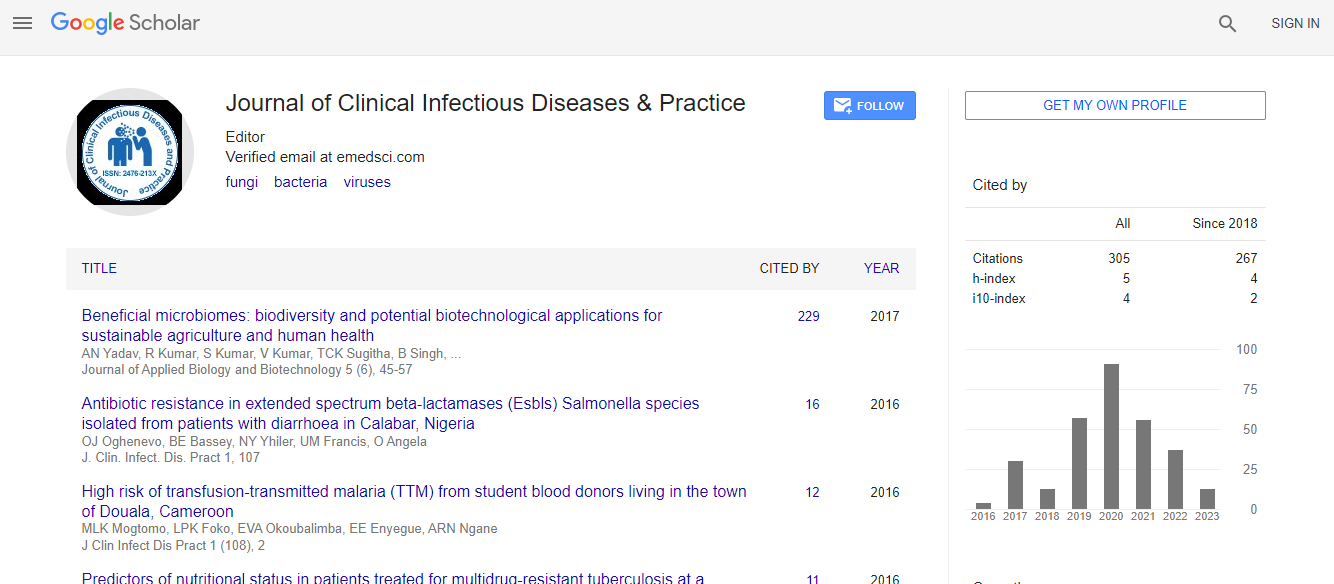Our Group organises 3000+ Global Conferenceseries Events every year across USA, Europe & Asia with support from 1000 more scientific Societies and Publishes 700+ Open Access Journals which contains over 50000 eminent personalities, reputed scientists as editorial board members.
Open Access Journals gaining more Readers and Citations
700 Journals and 15,000,000 Readers Each Journal is getting 25,000+ Readers
Google Scholar citation report
Citations : 531
Journal of Clinical Infectious Diseases & Practice peer review process verified at publons
Indexed In
- Google Scholar
- RefSeek
- Hamdard University
- EBSCO A-Z
- Publons
- ICMJE
Useful Links
Share This Page
Clinical case of congenital hyperinsulinism in infant born by mother with type 2 diabetes
9th World Congress on Rare Diseases and Orphan Drugs
N B Belykh, A Yu Philimonova and A D Bazhenova
Omsk State Medical University, Russian Federation
ScientificTracks Abstracts: J Clin Infect Dis Pract
Abstract
Relevance: Congenital hyperinsulinism (CHI) is a rare hereditary disease characterized by insulin hypersecretion and severe persistent hypoglycemia in children.Aim: The aim of the study is to present a clinical case of CHI in a child born of mother with type 2 diabetes.
Patients & Methods: Analysis of the clinical case and medical documentation.
Results: The girl from the 3rd pregnancy proceeding against the background of type 2 diabetes, 3 preterm births (35-36 weeks), weigh is 3410 g. After birth, the glycaemia was 0.1 mmol/l and then stabilized (5.0-4.3 mmol/l). In the first year of life glycaemia was in the range of 3.0-4.0 mmol/l, the neurodevelopment corresponded to the age. At 11 months of age, the level of insulin was 17.4 μE/ml. At the age of one year on the background of a long hungry pause glycaemia was 1.6 mmol/l; the child became lethargic, convulsions were noted. The girl was urgently hospitalized in the hospital with suspected CHI. The diagnosis was confirmed in the National Research Center for Endocrinology, where during the examination the glycaemia was 2.7 mmol/l, insulin-3.78 μE/ml, C-peptide-0.731 ng/ml. On the background of diazoxide intake in a dose of 5.6 mg/kg/day after a hungry period of 11.5 hours, glycaemia-2.9 mmol/l, ketonemia-1.1 mmol/l, insulin-1.56 μE/ml. To clarify the variant of the disease is carried out molecular genetic study. The child was prescribed diazoxide therapy (5.6 mg/kg/day), against which persistent euglycaemia and adequate insulin suppression are achieved. The girl is currently under the supervision of a pediatrician and endocrinologist at the place of residence. The tolerability of the therapy is satisfactory. Glycaemia rates correspond to the norm; the child does not lag behind his peers in neurodevelopment.
Conclusion: The disease manifested itself as a hypoglycemic state on the 2nd day, but later, due to the absence of signs of hypoglycemia, the condition was regarded as transient. The manifestation at the age of one year required an in-depth examination of the child, during which the CHI was diagnosed.
Biography
N. B Belykh is a pediatrician. She is working as an Associate Professor in Department of Pediatrics at State Pediatric Medical University, Russia. She published several articles in many journals.
E-mail: nbelyh68@mail.ru

 Spanish
Spanish  Chinese
Chinese  Russian
Russian  German
German  French
French  Japanese
Japanese  Portuguese
Portuguese  Hindi
Hindi 
